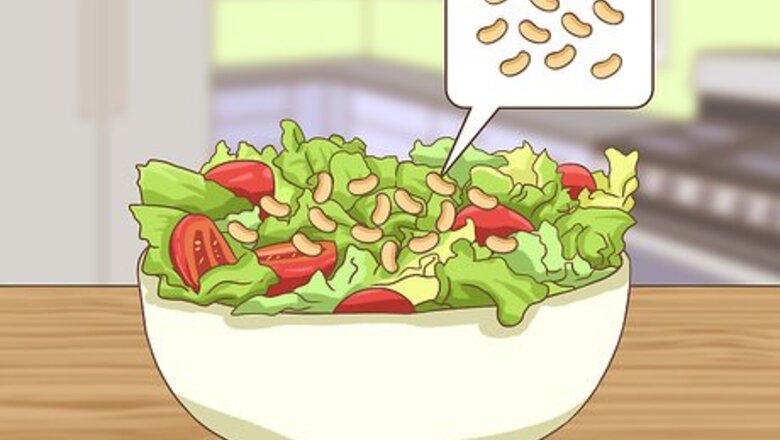
views
X
Trustworthy Source
Centers for Disease Control and Prevention
Main public health institute for the US, run by the Dept. of Health and Human Services
Go to source
Saturated fats and trans fats both raise LDL levels, so keep these out of your salad.[2]
X
Trustworthy Source
American Heart Association
Leading nonprofit that funds medical research and public education
Go to source
Fortunately, many ingredients that are commonly included in salads—such as various garden vegetables—are high in antioxidants, which help lower cholesterol levels. High-fiber foods also help your body process and remove bad cholesterol, so make sure to incorporate plenty of fibrous greens into your salads.
Eating Foods that Lower Bad Cholesterol

Top your salads with a portion of beans. Beans are high in soluble fiber, which binds to cholesterol and prevents it from entering your circulation. Research studies have indicated that adding half a cup of cooked beans to your salad (when eaten once daily for two months) can substantially reduce your high cholesterol. When adding beans to your salad, plan to start with common varieties including black and pinto beans. These should all be in stock at your local grocery store. Once you’re familiar with these types of beans, you can branch out into less common types of bean including garbanzo and navy beans. Other legumes will have the same beneficial effect of lowering bad cholesterol: try adding a handful of sprouts, a dollop of hummus, or a serving of falafel to your next salad.
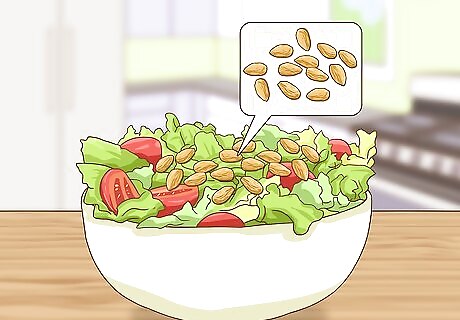
Add a handful of nuts to your salad. Topping your salad with a moderately sized handful of nuts, such as almonds, pecans, or walnuts, can decrease your LDL (bad) cholesterol by 10%. If you’re not in the mood for nuts on your salad, consider substituting a handful of healthy seeds, such as sesame, sunflower, or flax seeds. In addition to providing healthy, unsaturated fats and delicious flavors, nuts are also a substitute for high-cholesterol croutons. Croutons, as with many other breads and grain products, are high in bad cholesterols.
Add olives to block the oxidation of cholesterol. Black and green olives are a powerful cholesterol buster. Add them straight or make an olive pesto or tapenade.
Top your salad with stir-fried shiitake mushrooms. Shiitake mushrooms have been found to have properties that lower cholesterol. Give them a quick stir fry, then add them directly to your salad. You can also boil the mushrooms, if you prefer.
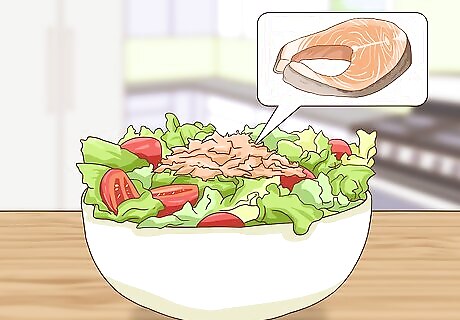
Try salmon with your salad. Unlike other types of fatty, unhealthy meat, salmon is actually quite healthy when added to a salad. Salmon is a fatty food, but its fats are good for your health: the fish is high in omega-3 fatty acids, which boost your heart health and can help lower LDL cholesterol. Salmon is a rich fish with plenty of flavor, so you won’t need to put a large amount on a salad in order to taste the fish. Like most fish, salmon can be pulled apart into neat “flakes” once it’s been cooked. Cook your salmon—say, a quarter pound—and then flake off as much as you please on top of your salad.
Avoiding High-Fat, High-Cholesterol Foods

Limit the amount of meat you put on your salad. Meat is high in fats and bad cholesterol and should be put on a salad only sparingly, if at all. High-fat meats and fried meats—such as bacon—are among the least-cholesterol-friendly types of meat to put on a salad. Fatty meats are high in saturated fats and cholesterol, both of which raise the level of "bad" LDL cholesterol in your body. If you enjoy meats on your salad, opt for a leaner cut. Look at your local deli for lean cuts of meat (those that contain less fat), or purchase a package of cold-cuts that is marked “low fat.” Opt for lighter meats—such as turkey and chicken—over fatty pork and beef.
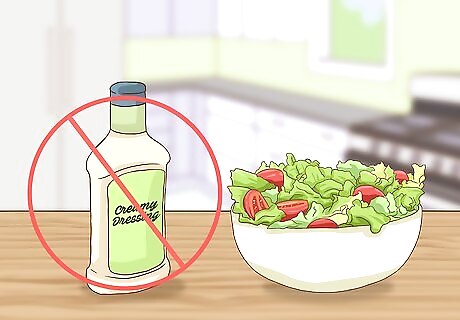
Skip the creamy dressing on your salad. Creamy, rich salad dressings tend to be high in fats—especially saturated fats—which will increase the levels of cholesterol on the salad. Avoid these fatty salad dressings; to check which dressings are relatively high in saturated fats, examine the nutrition facts label on the back of the salad-dressing bottle. Thinner, vinegar- and oil-based dressings—such as balsamic vinaigrette—will contain less bad cholesterol than rich, creamy dressings including ranch and blue cheese. You can also skip the dressing altogether, and substitute a few cut-up pieces of fruit. Slice a sweet and juicy fruit (like an orange or a handful of strawberries) into bite-sized cubes and toss the fruit in with your salad.

Hold the cheese. If you normally put shredded or crumbled cheese on your salads, you may want to reconsider. Many of the types of cheese commonly added to salads—such as feta, blue cheese, cheddar, mozzarella, and gouda — are high in saturated fats, which are directly linked to LDL cholesterol. If you’d still like to serve cheese on your salad, look at your local grocery store for cheeses marked “low fat,” as these will have fewer saturated fats and less cholesterol. Serve these cheeses in moderation on your salad. You can also add a dollop of cottage cheese to your salad, as cottage cheese is low in cholesterol.
Making Your Salad with Low-Cholesterol Greens
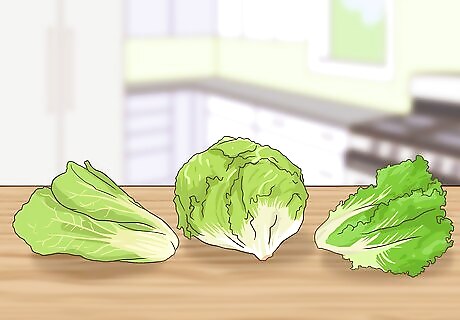
Innovate with your lettuce choices. Lettuce is the foundation of most types of salad, and many types of lettuce or lettuce-substitutes should be available at your local grocery store. When choosing lettuce for your salad—romaine, iceberg, green leaf—be aware that they’re all cholesterol-friendly. Use the type of lettuce that you prefer, or change the types you eat for the sake of variety. If you’re tired of the three mentioned types of lettuce, consider expanding to spinach leaves, spring leaves, kale, or a mix that combines multiple types of lettuce. Spinach is a healthy and delicious lettuce substitute; it’s high in fiber (a cup of spinach contains 6 grams of fiber), which helps your body lower its levels of cholesterol.

Add a variety of vegetables to the salad. Nearly all garden vegetables are very low in fats and contain no saturated fats, making them ideal candidates for you to include in salads. It’s especially important that you include veggies that are high in antioxidants, which help lower your body’s cholesterol levels. When you’re shopping for salad ingredients at your local grocery store, look for veggies like cabbage, carrots, onions (either raw or cooked), soybeans, and tomatoes. Many of these ingredients can be chopped and served on top of your salad, while others—including cabbage—can be used in the place of lettuce itself.
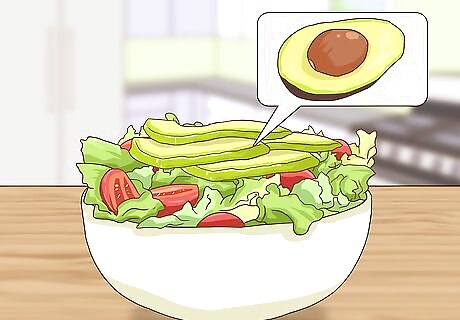
Include a sliced avocado with your salad. Although avocados are a fatty food, they contain significant amounts of good, healthy fats—including oleic acid and monounsaturated fats—and do not contain high amounts of saturated fats. Consequently, avocados will help raise your levels of good cholesterol, and lower levels of bad cholesterol. Avocados are commonly served as a garnish on the top of a salad. Cut each avocado half into thin slices, and arrange these on top of your salad. Alternately, cut each avocado half into half-inch squares, and sprinkle a half-cup or so on top of your salad.
Trying Healthy Salad Recipes
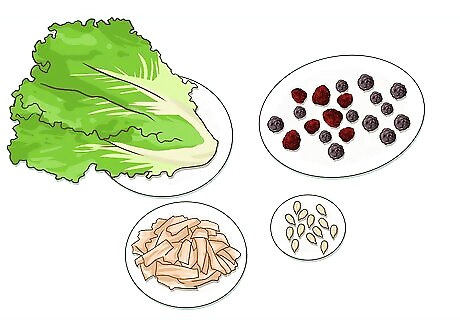
Make a tuna salad to encourage low cholesterol. Fishes like tuna have healthy fats and low cholesterol, so make a flavorful and healthy topping to a salad. Begin your salad with a base of mixed greens (spinach, romaine, etc.), and top it with a 2- or 3-ounce portion of tuna. For additional flavor and textures, add about 2 tablespoons each of healthy grains including sunflower seeds, dried cherries or raisins. Dress your tuna salad with a balsamic vinaigrette, or lightly garnish it with an oil-based dressing.

Build your salad around grapefruit and green apples. These low-fat fruits are also high in fiber, which will help keep your cholesterol levels low. To make this minimalist salad, cut up and combine 2 ½ cups of grapefruit with 1 ½ cups of green apples. If you would prefer not cut up the grapefruit—which could result in a large amount of liquid in the salad—try pulling the slices into finely “shredded” segments. Mix in 2 or 3 tablespoons of diced walnuts for added flavor, texture, and heart-friendly omega 3 fatty acids. Serve the salad immediately. If you find it tastes under-seasoned, salt and pepper the salad to taste.

Dress your salad with a light oil-based dressing. Oils commonly used to dress salads include extra virgin olive oil, canola oil, peanut oil, and flaxseed oil. Compared to thick, creamy salad dressings, these contain a higher percentage of healthy fats that help reduce cholesterol levels. They are still high-fat foods, so use a small amount with other flavorful ingredients. For example, mix ½ cup of olive oil with 2 tablespoons of lemon juice, ¼ teaspoon of paprika, 1/8 teaspoon of dry mustard, and 1 teaspoon of sugar. Combine all of these ingredients in a mixing bowl and beat together until well blended. The liquid ingredients may separate, so be sure to shake the dressing well before serving.




















Comments
0 comment